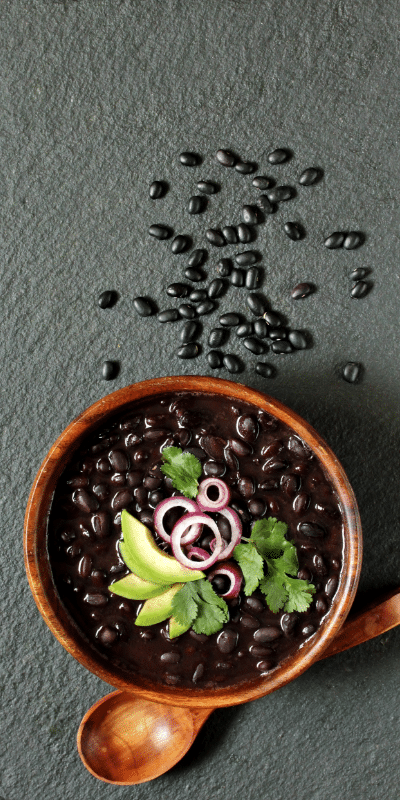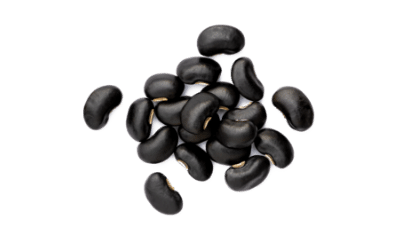
The virtues of black beans
Black beans are part of the legumes and have many benefits for humans and the planet. They have a central place in the food transition. Black beans are rich in carbohydrates and proteins (24.4 g of protein per 100 g). They contain dietary fiber and contain many minerals:
- Rich in magnesium: Magnesium contributes, among other things, to the reduction of tiredness and fatigue, to normal muscle function, to energy-yielding metabolism and to the normal functioning of the nervous system.
- Rich in iron: Iron contributes, among other things, to normal cognitive function, to normal energy-yielding metabolism and to normal immune function.
- Rich in phosphorus: Phosphorus contributes to the maintenance of normal bones and teeth and to energy-yielding metabolism.
- Source of calcium: Calcium contributes to energy-yielding metabolism, to muscle function and to the normal functioning of digestive enzymes. It is also necessary for the maintenance of normal bones and teeth.
Nutritional Value
When is the right
time to eat them?
Black beans are available in dried or canned form, making them suitable for eating throughout the year. They are harvested in the summer and last until September.
The right time to sow it
Black beans are part of the Fabaceae family. They are a legume that is native to South America, where they are commonly consumed.
Seeds are sown from early May to early July. Place one seed every 10 cm in rows spaced 40 cm apart in warmed soil and water them regularly in dry weather.
Black beans are harvested about 2 months after sowing, in summer and until September. In France, they are available all year round in grocery stores and other stores. Black beans are available dried or canned.
Choosing and
storing
While black beans are most commonly sold dried, they can also be found in the canned and jarred section. The latter are easier to prepare, as canned and jarred black beans are already soaked and cooked beforehand.
Black beans, whether dried or canned, can be stored for several months at room temperature. Keep them away from light and heat. After cooking, they can be stored for a few days in the refrigerator or even in the freezer.
Tips and
tricks
Black beans are a perfect accompaniment to raw vegetable salads, vegetable curries with coconut milk, Mexican rice with cumin, jalapenos, lime and fresh parsley or even Cuban soups. They also go very well with fresh herbs! Not to mention revisited chilis (con or sin carne), sautéed meat dishes, vegetable stews and fragrant curries.
Did you know?
Its black color and slightly sweet flavor make it a perfect ally for… brownies! Black beans can also be found in the form of flour, which you can use as a base for pancakes for example.
- Soaking time: +/- 12 hours
- Cooking time: 1 hour to 1 hour 30 minutes, depending on the desired texture
What is the environmental impact of black beans?
The environmental score “PEF” (Product Environmental Footprint) tells us more! This is a score established by Agribalyse*. It takes into account all the stages of the vegetable’s life cycle: how is it grown, what is the impact of transport and processing, etc.? The lower the score, the lower its impact on the environment. Since black beans are not included in the Agribalyse database, here is the information for red beans:
- Red beans, dry: 0.12
- Red beans, cooked: 0.06
- Beef steak, raw: 2.77
CO2 equivalent: for 100 g of red beans (dry): 0.095 kg of CO2 eq, or as much as 2.8 g of raw beef steak.

Can everyone
eat them?
Legumes, like black beans, can be added to your baby’s diet from 6 months. Add them gradually, at a rate of one or two spoonfuls of pureed split peas. From 12 months, your baby can eat up to 70 grams of cooked legumes per day.
Legumes remain little consumed by the general population… Yet they are essential in a more sustainable diet! They have a reduced environmental impact and provide essential nutrients for humans.
Where do they come from?
Origins and varieties
The black bean is native to South America. Today it is very common in South American and Mexican cuisine, but is not widely consumed in Europe. It is also widely consumed in Asia and Brazil. Among the black beans, the Brazilian black dwarf bean and the Black turtle black dwarf bean are the best known.



 Cabbage
Cabbage  Lamb’s lettuce
Lamb’s lettuce  Vegetable garden: growing Jerusalem artichoke
Vegetable garden: growing Jerusalem artichoke 









